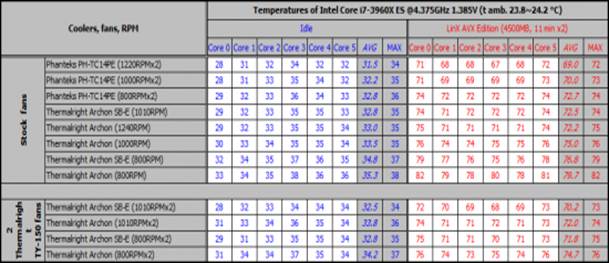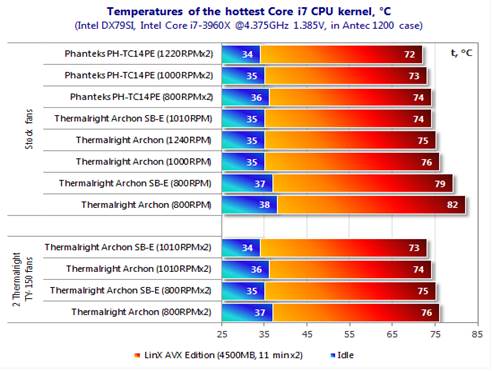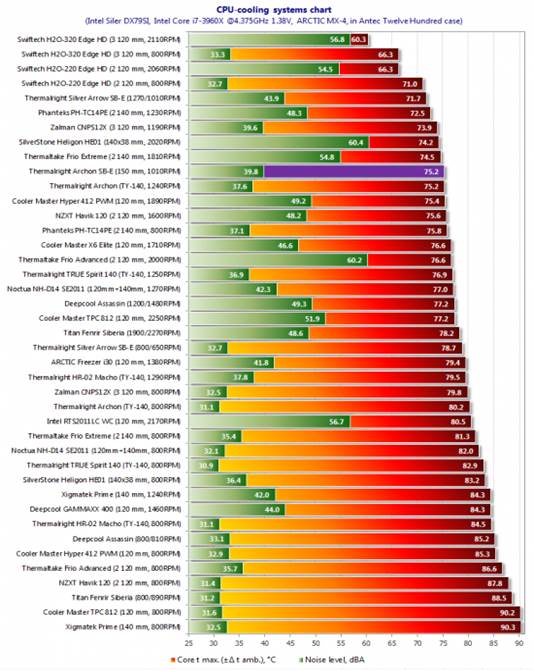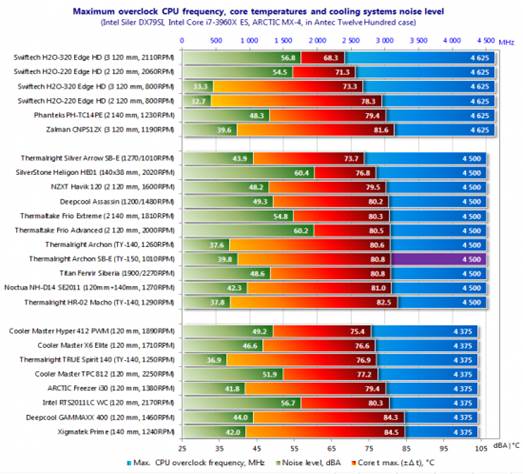Performance
Cooling
efficiency
You can see the testing results of the
cooling efficiency in the diagram and table below:

Table
comparing the results

Chart
comparing the results
First, we check the coolers out with their
default fan. The truth is, Archon SB-E is not able to show us anything special.
At maximum speed of the 150 mm fan, it's just 1oC ahead of the
original Archon with TY-140 140mm fan At 800 RPM, Archon SB-E is 3oC
more effective than the Archon at a same pace. But then, if the speed increases
from 800 to 1,000 RPM, the Archon SB-E is 3oC worse. After the test,
we can tell you that the original Archon is superior to the SB-E version in
terms of noisiness.
The overall best air cooler Phanteks
PH-TC14PE is far more efficient than either Archon even at the minimum speed of
its two 140mm fans.
Equipped with two TY-150 fans, both Archon
models are nearly identical in terms of performance. SB-E version seems a
little better, about 1oC at any speed. Unfortunately when the
technological developers had reduced the number of heatsink fins in the Archon
SB-E and thus reduced the total heat dissipation area, which is a very
important factor at very high loads. We guess that the Archon SB-E would be definitely
better when compared with its predecessor and might even compete with the
Phanteks PH-TC14PE if it had the same surface area.
You can compare its performance with
products we tested previously in the following diagram. Each cooler is tested
in its default configuration with the CPU overclocked to 4,375 MHz at a voltage
of 1,385 volts.

Chart
comparing the results
As you can see, Thermalright Archon SB-E is
in the leading group, but it is still not better than the original Archon.
When we tried to overclock the CPU when
cooling it with Thermalright Archon SB-E in the following configuration (with a
150mm fan), we found that the CPU is able to work at 4,500 MHz and at a voltage
of 1,435 volts. The CPU's highest temperature is 81oC. That's good,
but it's not an outstanding result. Especially the original Archon also had an
equally good result as the new version in terms of maximum CPU clock rate.

Chart
comparing the results
Sound
efficiency
We measure the noise level of the two
tested coolers with full fan speed. And here is the result:
Notwithstanding the lower speed, the
Thermalright TY-150 is louder than the older TY-140 fan. The difference is very
high. While the TY-140 remained stable up to 1,170 RPM, the TY-150 became slow
down in the rate of 870-880 RPM. To achieve quietness, the TY-140 has to
operate at 1,020 RPM and the TY-150, at 730 RPM. It turned out that the
original Archon is better than the SB-E version in performance at the same
noise level.
So, we do not think the 150 mm fan installed
in the new version is a good solution. On the other hand, we can note that
neither Archon is quieter than the Phanteks with its two 140mm fans.
Conclusion
Unfortunately, Thermalright Archon SB-E
does not make us surprised at the performance as well as low noise level as the
original did in the old days. We guess there is a reason for this.
Firstly, the total surface of the Archon
SB-E heatsink is 10% smaller than the original Archons’, this certainly affects
its performance because this parameter is particularly important for the
coolers that have to work with very hot CPUs. Any superior cooler has a
heatsink with a total surface of no less than 10,000 cm2 whereas the
Archon SB-E is only about 8,000 cm2.
Secondly, its installation is less
reliable. The plate bends when you tighten the screws, so the pressure will be
lower than the original. Archon SB-E seems to have a curved base (not just
convex, but highly uneven), this must have been a negative factor leading to
its unimpressive performance.
Thirdly, while the fins of the Archon SB-E
heatsink are spaced out at larger distance, the TY-150 fan at 1,100 RPM (or 1,010
RPM according to our monitoring tools) is not a good alternative for the TY-140
fan in terms of sound and performance. As a result, the new version of Archon
is only 1oC better than the original version but inferior to the
latter in noise.
We guess this is because the Archon SB-E
will quickly be replaced by Archon SB-E X2 version which is equipped with two
TY-141 fan and features improved fasteners from the Archon (referred to as
Pressure Vault Bracket System). We will test it in the lab soon, so do not
change the attitude of lime!
|
Thermalright
Archon SB-E technical specs
·
Dimensions (LxWxH), mm: 175x155x79.5
(170x150x26.5)
·
Weight, g: 940 (760- for the sink heat only)
·
Materials and design: nickel-plated tower
heatsink is assembled from aluminum foil, placed in eight copper heatpipes 6
mm in diameter, the tubes pass through the heatsink base
·
Number of thermal fins: 44
·
Thermal fin thickness, mm: 0.5
·
Distance between thermal fin, mm: 2.3
·
Calculated area of heat dissipation, cm2
~8,000
·
Type and module of fan: Thermalright TY-150
·
Fan's rotation speed, RPM: 500-1100 (±10%)
·
Airflow cooling, CFM: 38-84
·
Noise level, dBA: 19-23
·
Fan bearings: Enhanced Hyper-Flow Bearing
(EHFB)
·
Nominated/boot voltage, A: 12
·
Fan's current, A: 0.2
·
Energy consumption of fan, W: 2.4
·
Compatible CPU sockets: LGA
775/1155/1156/1366/2011,Socket 939/AM2(+)/AM3(+)/FM1
·
Other information: Can accompany a 2nd fan,
Thermalright The Chill Factor III thermal paste.
·
Price: $79
|